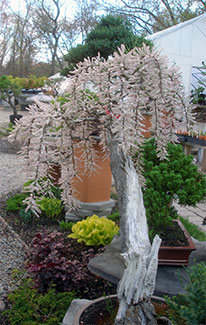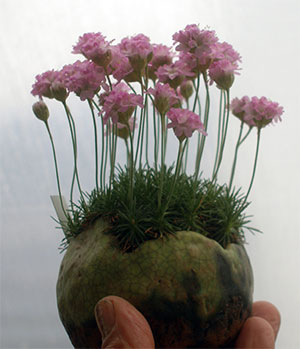Four Seasons of Bonsai: Spring
 April-June
April-June
April is beginning of the first growing season here in New England. At Bonsai West, we divide the growing season up into thirds: April and May; June, July, and August; and September and October.
By the middle of April we are opening our cold frames and beginning to put our most cold-hardy trees outside.
Trees are tender this time of year. Be careful to place your trees in a protected place out of the wind at first, and watch the weather daily to make sure temperatures are above freezing. And most important: be willing to pull them in even for one night if the weather seems to be getting below 34 degrees.
 By the end of the month all of our cold-hardy trees are outside and we are starting them on our fertilizing regime with a combination of slow-release organic foods and liquid fertilizer such as a reduced strength of our own Green Dragon Bonsai Food or Miracle Gro.
By the end of the month all of our cold-hardy trees are outside and we are starting them on our fertilizing regime with a combination of slow-release organic foods and liquid fertilizer such as a reduced strength of our own Green Dragon Bonsai Food or Miracle Gro.
We hold our tropicals indoors until the second week of May, after the fear of a late frost is gone. By now they have started to grow and are reaching towards the sun. We keep them pruned hard and gradually increase their fertilizer as well.
It’s time now to finish up transplanting all of the conifers, and to start thinking about all of the summer projects including transplanting your indoor trees.
We have been fertilizing frequently and watering well to promote vigorous growth. For all of you indoor bonsai growers: consider putting your trees outdoors this summer if at all possible, even if all you have is a balcony! You will be amazed how much better they will do because of the increased sun and ventilation and just all-around better natural conditions! If you decide to do this, start by placing your trees in the shade and gradually move them into the sun over a period of weeks. Remember though that trees that grow outdoors will need more water than ones grown indoors.
 Insects and Fungus
Insects and Fungus
Some people tell us that they are worried about bugs outdoors, but this is nothing to worry about. When trees are healthy they are less apt to get infested with insects and because of that they are actually less prone to insects than when grown inside.
As for insects: The common insects for you? to be on the lookout for are Scale, Mealy bugs and Aphids. All of these can be treated with over-the-counter insecticidal sprays and systemic insecticides. If you do have an insect problem, be sure that you make several applications of your chosen insecticide over a period of two to three weeks in order to kill the bugs and their newly hatched eggs.
Another common problem with bonsai in the spring is fungus. Black Spot will attack elms during this rainy season, and Powdery Mildew likes to attack apple trees. There has been an increase in the probability of getting Apple Cedar Rust and Tip Blight on your junipers in the New England area because of the proximity of apple trees, which are the host for this blight, growing near junipers. Fortunately, we have been able to control these problems on our trees and our customer’s trees that are left here for winter boarding.
 There are many treatment products for sale and you can find a huge amount of information on-line about the various fungi and their cures. If you have a problem, please don’t hesitate to give us a call.
There are many treatment products for sale and you can find a huge amount of information on-line about the various fungi and their cures. If you have a problem, please don’t hesitate to give us a call.
Repotting, Pruning, Watering
Early Spring is the time for repotting and pruning. The general rule of thumb is to re-pot deciduous, azalea, and tropicals every two to three years, and your Juniper and pines every three to five years.
While it is too late for repotting your maples (that should have been done in March) it is still a good time for repotting junipers and azalea as well as elms – not to mention that you still have the next two months to repot all of your tropicals!
Over-watering trees is a common problem in the winter, however now that there are longer brighter days your trees should be drinking much faster and you need to be sure not to let them dry out. We find that dunking your indoor trees in a deep tub of water or sink is still the best way to saturate them. Use your finger to probe into the soil to make sure it is at least half way dry before watering them.
Our customers are always asking if we use moisture meters. The answer is yes we do: we use our finger and eyes. Recognizing when the soil is too wet or dry is one of the most important parts of growing bonsai.
 Summary of tips
Summary of tips
- Start moving cold hardy trees out doors, be prepared to protect from freeze
- Fertilize more frequently
- Water more often when outdoors
- Prune all tropicals hard to promote vigorous spring growth
- Clean old pine needles and prune junipers
- Spray for insects and fungus
- Finish potting cold hardy trees in April
- Start potting tropical trees in June
- Remove old wire to prevent scarring
- Time to start weeding again!